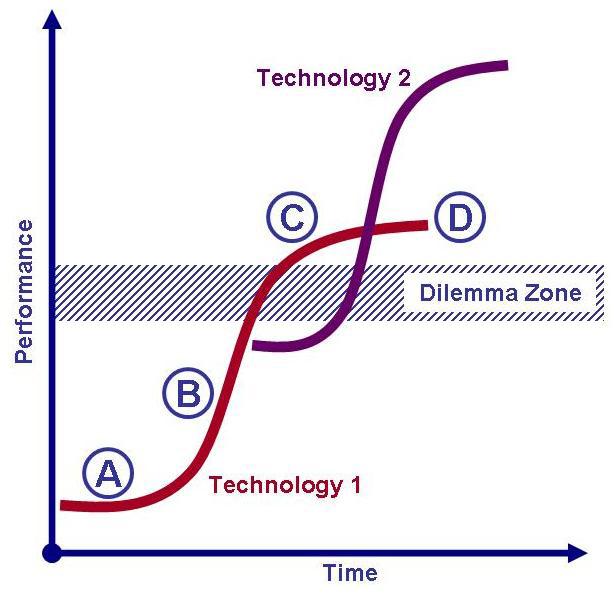A little about the innovator dilemma in IT
In 1997, Clayton Christensen, a professor at Harvard Business School, graduated and published his book, The Innovator’s Dilemma. How big companies are dying because of new technologies. ” A small book of 2 chapters describes in detail the essence of "disruptive" innovations and their impact on business. Once inspired by this book, we decided to create our own widget.
In the book, Christensen gives a clear definition of the dilemma of the innovator - it is "a phenomenon when people who invent something are the last to see what is behind it." It looks like this:

The innovator’s dilemma is directly related to the concept of “reinvent the wheel” - a phenomenon when someone simply copies something from someone. However, the bike itself was created by more than one person - in 1817, Professor Dres created the first bicycle, but he was without pedals. After 20 years, Thomas McCall invented the pedals, but could not make the wheels equal in size - only in 1885 did John Starley collect everything that was invented before him, added his research and created the bicycle in the form in which we know now.
If you look at the development of technologies or individual services over the past 30-40 years, you can see that the situation is exactly the same in IT.
Facebook was not the first social network - SixDegrees appeared in 1997, and even earlier there were Classmates (however, it is difficult to call it a social network, therefore it is generally accepted that SixDegrees became the first social network in the world).
By the time Zuckerberg sat down to write the first line of code for Facebook, Ryze (2001), Friendster (2002), and MySpace (2003) were already in the United States. In Asia and Latin America, there were BlackPlanet, AsianAvenue, LunarStorm and Cyworld.
Moreover, Facebook was not the first social network for students - back in 2001, Orkut Buyukkoten launched Club Nexus at Stanford, which Google later bought and renamed in honor of the creator. By the way, the project did not take off and in 2014 was closed.
Long before Segalovich created Yandex, and Page and Brin - Google, in the technology mecca, MIT, students created the world's first search engine called Wandex. It was the year 1993. All subsequent search engines used the best practices and the Wandex algorithm, making their improvements to it.

In 1994, McAfee, now known for its security systems, created the PowWow messenger, which became the progenitor of AOL and ICQ.
And of course, the most daring pirate raid in IT, executed by IBM and Apple, when Xerox PARC was adopted and even stolen in places, among other things, the technology for displaying information on the screen in raster graphics.
If you look at the history of each product or company, which today is the market leader, you can see that the percentage of pioneers among them is quite small. Almost always, someone creates a technology, and someone improves it and crushes the market for themselves. Naturally, provided that it is truly disruptive technology.
By the way, back to the book. The term “creative destruction" first appeared there, a phenomenon when a new technology is so disruptive that it kills the previous one and its leader. The most striking example is film photography and Kodak, which filed for bankruptcy in 2012.

In 2014, we worked in the same company and installed several callback widgets on our website. We liked the idea very much, but we saw that each of them has drawbacks - some have a non-working caliper, others have no obsession regulated, others have too high prices. We decided to take the technology, improve it and sell it at the lowest price. So there was Rocket Callback.
What exactly have we improved:
1. They made it possible to set a photo of the manager so that customers knew who they were talking to. This is only the beginning, as we have plans to make a completely personalized widget so that the manager knows who is calling him. To do this, we will try to use the Facebook Messenger API, the Zopim experience and callback technology.
2. We made a fully adjustable obsession, so that the widget was a living hell at 100% or appeared only on a click at 0%. You can generally hide the button and it will catch clients when entering or leaving the page.
3. Make the widget smart so that it learns and determines for itself who to offer the call to and who not. All data (user clicks, mouse movements, scrolling, inactivity, requests, clicks, referral sources, visit number) is thrown into our Hadoop on Azure, and then launched into Machine Learning. So Rocket collects information about the visitor and adapts to a particular site.
4. Made it possible to choose a color. A trifle, but nice. 10 primary colors, setting the palette, down to transparent, adjusting the size and location of the button, the size of the widget window, the color of the button. You can go to our website, enter your address and see how the widget will look, play with color.
5. Set the lowest price in Russia. For example, now we have 1 tariff - $ 7. At today's rate, it is about 370 rubles. 50 minutes for 370 rubles. If you consider that each conversation lasts about 2 minutes, then 50 minutes is 25 potential customers for 370 rubles. Moreover, we also tried to bring the quality of communication to the ideal.
Naturally, all this is never disruptive technology, but only improvement and development, but they already provide us with a difference from competitors. Well, plus we have several plans - personification, AI improvement, update the design, expand the configuration tool, integrate with CRM and other services, add analytics.
Returning to the dilemma. It really exists, and the only question is who and how will be able to improve the technology invented by others. We hope that we will be able to realize all the plans, and we will be able to move so far away from the original product that it will be a new technology, which, in turn, will be improved by someone else, bringing to another new one. And so on ad infinitum. By the way, we advise you to read a book - despite the fact that it was published back in 1997, it is still relevant, as it contains a scientific approach.

Thanks for reading us!
Subscribe to our blog .
In the book, Christensen gives a clear definition of the dilemma of the innovator - it is "a phenomenon when people who invent something are the last to see what is behind it." It looks like this:

The innovator’s dilemma is directly related to the concept of “reinvent the wheel” - a phenomenon when someone simply copies something from someone. However, the bike itself was created by more than one person - in 1817, Professor Dres created the first bicycle, but he was without pedals. After 20 years, Thomas McCall invented the pedals, but could not make the wheels equal in size - only in 1885 did John Starley collect everything that was invented before him, added his research and created the bicycle in the form in which we know now.
If you look at the development of technologies or individual services over the past 30-40 years, you can see that the situation is exactly the same in IT.
Facebook was not the first social network - SixDegrees appeared in 1997, and even earlier there were Classmates (however, it is difficult to call it a social network, therefore it is generally accepted that SixDegrees became the first social network in the world).
By the time Zuckerberg sat down to write the first line of code for Facebook, Ryze (2001), Friendster (2002), and MySpace (2003) were already in the United States. In Asia and Latin America, there were BlackPlanet, AsianAvenue, LunarStorm and Cyworld.
Moreover, Facebook was not the first social network for students - back in 2001, Orkut Buyukkoten launched Club Nexus at Stanford, which Google later bought and renamed in honor of the creator. By the way, the project did not take off and in 2014 was closed.
Long before Segalovich created Yandex, and Page and Brin - Google, in the technology mecca, MIT, students created the world's first search engine called Wandex. It was the year 1993. All subsequent search engines used the best practices and the Wandex algorithm, making their improvements to it.

In 1994, McAfee, now known for its security systems, created the PowWow messenger, which became the progenitor of AOL and ICQ.
And of course, the most daring pirate raid in IT, executed by IBM and Apple, when Xerox PARC was adopted and even stolen in places, among other things, the technology for displaying information on the screen in raster graphics.
If you look at the history of each product or company, which today is the market leader, you can see that the percentage of pioneers among them is quite small. Almost always, someone creates a technology, and someone improves it and crushes the market for themselves. Naturally, provided that it is truly disruptive technology.
“Disruptive innovation” is an innovation that changes the balance of values in the market. At the same time, old products become uncompetitive simply because the parameters on the basis of which competition was held earlier become unimportant.
By the way, back to the book. The term “creative destruction" first appeared there, a phenomenon when a new technology is so disruptive that it kills the previous one and its leader. The most striking example is film photography and Kodak, which filed for bankruptcy in 2012.

In 2014, we worked in the same company and installed several callback widgets on our website. We liked the idea very much, but we saw that each of them has drawbacks - some have a non-working caliper, others have no obsession regulated, others have too high prices. We decided to take the technology, improve it and sell it at the lowest price. So there was Rocket Callback.
What exactly have we improved:
1. They made it possible to set a photo of the manager so that customers knew who they were talking to. This is only the beginning, as we have plans to make a completely personalized widget so that the manager knows who is calling him. To do this, we will try to use the Facebook Messenger API, the Zopim experience and callback technology.
2. We made a fully adjustable obsession, so that the widget was a living hell at 100% or appeared only on a click at 0%. You can generally hide the button and it will catch clients when entering or leaving the page.
3. Make the widget smart so that it learns and determines for itself who to offer the call to and who not. All data (user clicks, mouse movements, scrolling, inactivity, requests, clicks, referral sources, visit number) is thrown into our Hadoop on Azure, and then launched into Machine Learning. So Rocket collects information about the visitor and adapts to a particular site.
4. Made it possible to choose a color. A trifle, but nice. 10 primary colors, setting the palette, down to transparent, adjusting the size and location of the button, the size of the widget window, the color of the button. You can go to our website, enter your address and see how the widget will look, play with color.
5. Set the lowest price in Russia. For example, now we have 1 tariff - $ 7. At today's rate, it is about 370 rubles. 50 minutes for 370 rubles. If you consider that each conversation lasts about 2 minutes, then 50 minutes is 25 potential customers for 370 rubles. Moreover, we also tried to bring the quality of communication to the ideal.
Naturally, all this is never disruptive technology, but only improvement and development, but they already provide us with a difference from competitors. Well, plus we have several plans - personification, AI improvement, update the design, expand the configuration tool, integrate with CRM and other services, add analytics.
Returning to the dilemma. It really exists, and the only question is who and how will be able to improve the technology invented by others. We hope that we will be able to realize all the plans, and we will be able to move so far away from the original product that it will be a new technology, which, in turn, will be improved by someone else, bringing to another new one. And so on ad infinitum. By the way, we advise you to read a book - despite the fact that it was published back in 1997, it is still relevant, as it contains a scientific approach.

Thanks for reading us!
Subscribe to our blog .
